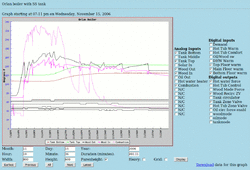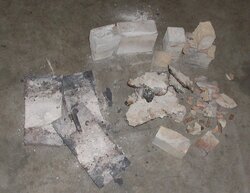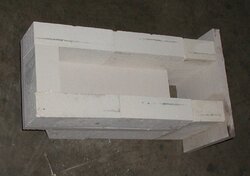I want to build a different combustion chamber baffle for my EKO 25. The insert that comes with the unit is a large block of firebrick with a trough in the top. It's hard to clean ashes from around it, and it doesn't maximize hot gas flow along the walls. I've built a much better design out of 8" square flue tile, but no good deed goes unpunished. It disintegrated from thermal stress. I glued it back together with refractory cement, and coated the whole assembly with fiberglass cloth and refractory cement. Same result. I then built the same thing out of 1/2" steel from snow plow blades and firebrick. Ate right through the steel and cracked the firebrick. Tried again with low-density firebrick, and melted some broken glass bottles on top of the steel to protect it. Kind of works, but ugly.
The structure that I want to build is essentially an 'H' beam about 10" high by 8" wide by 20" long. At present, two courses of firebrick make the sides, and the steel plate makes the web. It's just 'stacked in place'. It's set up so that the secondary combustion happens towards the front of the top channel. Gas flow is front-to-back in the top channel. The back end is sealed, and the back of the web is cut away so that the gas then flows down to the bottom channel, where it then flows back to the front. It then exits to the sides and flows back to the hx at the back end of the boiler. The serpentine path means that all the gas flows along the full length of the boiler walls, and ashes are really easy to clean out.
What materials are available out there for building a structure like this that can withstand 2200 degrees? I've seen what I think is a ceramic based board about 1/2" thick - that might be ideal. I can't find sources accessible to non-industrial buyers.
The structure that I want to build is essentially an 'H' beam about 10" high by 8" wide by 20" long. At present, two courses of firebrick make the sides, and the steel plate makes the web. It's just 'stacked in place'. It's set up so that the secondary combustion happens towards the front of the top channel. Gas flow is front-to-back in the top channel. The back end is sealed, and the back of the web is cut away so that the gas then flows down to the bottom channel, where it then flows back to the front. It then exits to the sides and flows back to the hx at the back end of the boiler. The serpentine path means that all the gas flows along the full length of the boiler walls, and ashes are really easy to clean out.
What materials are available out there for building a structure like this that can withstand 2200 degrees? I've seen what I think is a ceramic based board about 1/2" thick - that might be ideal. I can't find sources accessible to non-industrial buyers.





